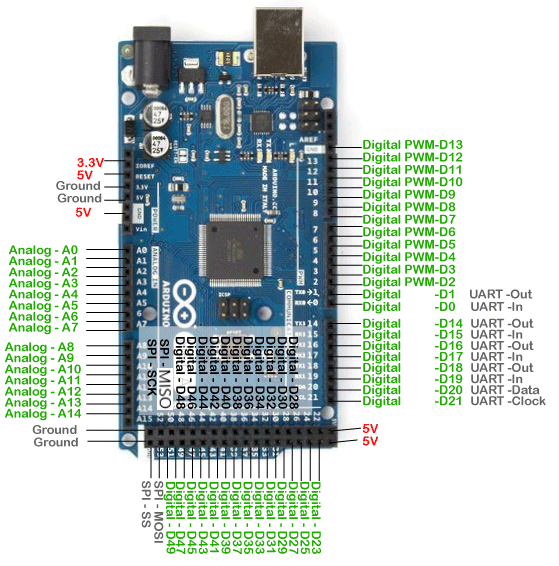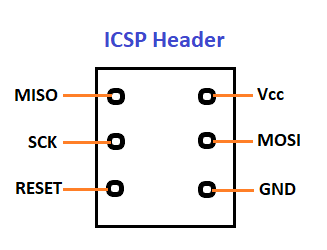Arduino Mega PinoutThe Arduino Mega is based on ATmega2560 Microcontroller. The advantage of using the Arduino Mega board over other boards is that it gives the advantage of working with more memory space. The Pinout of Arduino Mega is shown below: 
The description of pins present on the Arduino board are listed below:
It is used for the boards that require more memory, sketch, and I/O lines. It is recommended for complex projects, such as Robotics, etc.
It allows the board to connect to the computer. It is essential for the programming of the Arduino Mega board. We usually plug the USB cable in the USB port to load the sketch to the board.
It stands for Universal Asynchronous Receiver and Transmitter. It permits the Arduino to communicate with serial devices.
The power jack is used to supply the power to the board. The adapter is plugged-in to the power jack of the Arduino Mega board.
The program or firmware with the advanced functionalities is received by microcontroller with the help of the ICSP (In-Circuit Serial Programming) header. The ICSP header consists of 6 pins. The structure of the ICSP header is shown below: 
It is the top view of the ICSP header.
It is the two-wire serial communication protocol. It stands for Inter-Integrated Circuits. The I2C is a serial communication protocol that uses SCL (Serial Clock) and SDA (Serial Data) to receive and send data between two devices. The SCL is a clock line, while SDA is a data line.
There are total of 16 Analog pins from A0 - A15. The function of Analog pins is to read the analog sensor used in the connection. It can also act as GPIO (General Purpose Input Output) pins.
There are 54 digital Input/Output pins from pin numbered from 0 to 53. The 15 pins from the digital I/O are PWM (Pulse Width Modulation) pins numbered from D2 - D13 and D44 - D46. The digital pins have the value either HIGH or LOW.
It stands for Serial Peripheral Interface. It is popularly used by the microcontrollers to communicate with one or more peripheral devices quickly. The SCK stands for serial clock. In slave, it works as the input of the clock generator. In master, it works as the output clock. SPI can even have various devices on the bus.
It stands for Master In/ Slave Output. The slave line in MISO is used to send data to the master.
It stands for Master Output/ Slave Input. The MOSI line Arduino carries the data from Arduino to the control devices of SPI. The slave line in MOSI is used to send data to its peripherals. SS It stands for Slave Select. It is the Slave Select line, which is used by the master. It acts as the enable line. The MISO, MOSI, and SS support SPI communication. The multiple SPI devices in Arduino are able to share the same SS, MOSI, and MISO lines.
It stands for Input Output voltage REFerence. It allows the shields to check the operating voltage (3.3V or 5V) of the board. The shields are connected to the Arduino Board. The Microcontroller operates with the reference voltage provided by the IOREF.
Next TopicArduino Micro Pinout
|
 For Videos Join Our Youtube Channel: Join Now
For Videos Join Our Youtube Channel: Join Now
Feedback
- Send your Feedback to [email protected]
Help Others, Please Share










